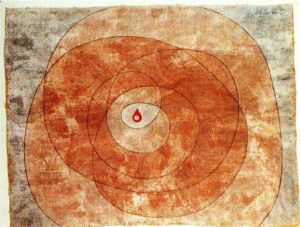
At the Core by Paul Klee
by Beth
This post explores the concept of core qualities and offers suggested practices to consider for inclusion in your classes, private sessions, and personal practice.
A core quality is a specific characteristic, strength, skill, or essence. Examples of these are clarity, alignment, balance, contentment, endurance, helpfulness, integration, resilience, and surrender. We may think these qualities are external goals we need to work toward but according to the yoga tradition they are already part of our being. Consider this line from the poem “Auguries of Innocence” by William Blake:
“To see a World in a Grain of Sand.”
If we are a grain of sand, we are also a world and everything in that world, including core qualities. How we experience our lives, with its joys and sorrows, can be attributed to how deeply we recognize, embody, and express this understanding.
Core qualities can be expressed in positive or unhelpful ways. For instance, helpfulness without boundaries can be unhealthy, surrender without wisdom can result in a loss of self-determination, and endurance without balance may lead to exhaustion. However, when consciously realized and viewed through self-awareness, core qualities are more likely to be expressed in positive ways.
Of course, this is easier said than done since the journey to true and deep self-awareness is long and often difficult. Our job as human beings, and yoga teachers, is to find ways of helping ourselves and others to understand this. Linking core qualities to our personal yoga practice and our teaching is an effective way to help ourselves and our students experience the deeper aspects of yoga. It enhances the benefits inherent in all yoga practices. Here are a few examples.
Asana: Anodea Judith, in her book Chakra Yoga, offers Tadasana (Mountain pose) as a way to embody, sense, and feel the core quality of alignment in both the physical and the energy body. She explains that when the body is vertically aligned from the feet to the crown of the head, our energy anatomy (the chakras, for example) aligns with the physical body. When practitioners find physical ease in holding the pose, it is possible to sense the quality of alignment physically and energetically.
Pranayama: In The Breathing Book, Donna Farhi suggests using a breath inquiry she calls The Essential Breath as a way to explore the quality of surrendering into the pauses at the end of inhaling and exhaling.
Instructions
- Come to a comfortable seated position.
- Bring your awareness to your breath.
- Notice that at the end of your inhalation there is a slight pause, or gap, before you exhale.
- Notice that at the end of your exhalation there is a slight pause, or gap, before you inhale.
- Let your breath come and go naturally—don’t try to change it in any way.
- Simply observe the ebb and flow of the natural, essential breath.
Mudra: Mudras can be thought of as a global positioning system for realizing a desired core quality. In Mudras for Healing and Transformation, Joseph and Lilian LePage highlight the core quality of integration, loosely defined as sensing and feeling that all separate parts of the self are integrated into the whole, which is the ultimate goal of yoga. Try Hakini mudra, a gesture of balance and integration
Instructions

- Sit with your spine comfortably aligned and soften your chest and shoulders.
- Hold your hands facing each other a few inches away from your solar plexus.
- Touch the tips of the fingers and thumb of your left hand to the corresponding fingers and thumb of your right hand.
- Create space between your hands as though you are holding a ball.
- Relax your hands in your lap, with the pinky sides of your hands, your wrists, and your forearms on your thighs or in your lap.
- Close your eyes or keep them slightly open and gaze down at the floor.
- Hold the mudra and sit quietly for 2 – 5 minutes, as long as you are comfortable.
- Focus on your natural breathing process.
- When you are ready to come out, release the mudra and stretch your body in any way that your body needs to stretch.
In my book, Enlighten Up! Finding Clarity, Contentment and Resilience in a Complicated World, I offer a down-to-earth, relatable look at the koshas—the five layers of self-awareness—and how to use this model to understand and embody core qualities in positive and helpful ways.
Yoga practices can be presented with more than one core quality. It depends on who your students are, what they need, and how you facilitate the class to meet those needs. Let’s take Balasana (Child’s pose) as an example. Depending on our intention, we can present the posture with the core qualities of grounding, alignment, support, protection, or restoration. We might help students:
- Hold the pose with blankets or a bolster to sense grounding, protection, or support.
- Facilitate a step-by-step process to enter and exit the pose to sense physical alignment.
- Find a level of restoration by holding the pose for several minutes once a comfortable variation is found that allows the practitioner to relax into the pose.
Placing a focus on core qualities offers us an opportunity to move ourselves a bit further along on the path to self-awareness.
Beth’s self-awareness newsletter is published six times a year. It features informative, inspiring and entertaining tips for finding clarity, contentment, and resilience in a complicated world. For more information and to sign up for the newsletter go to www.bethgibbs.com.
• Follow Yoga for Healthy Aging on Facebook and follow Nina on Instagram • Order Yoga for Times of Change here and purchase the companion videos here • Order Yoga for Healthy Aging: A Guide to Lifelong Well-Being here.


Leave A Comment